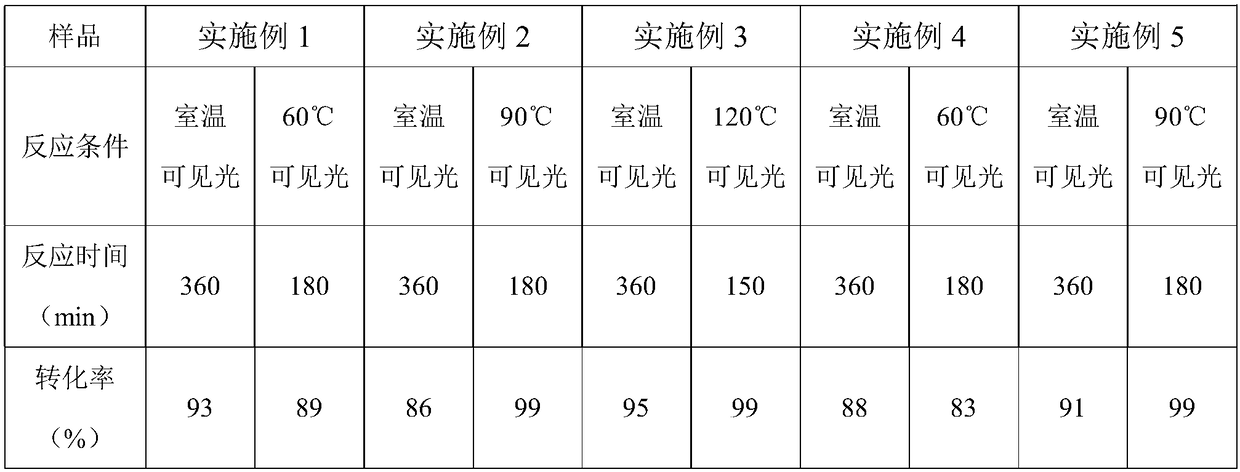Z-type catalyst with photothermal synergistic function and application thereof
A technology of photothermal synergy and catalyst, applied in the direction of physical/chemical process catalysts, chemical instruments and methods, chemical/physical processes, etc., can solve the problems of high Ag content, cumbersome operation, easy to be oxidized and deteriorated, and achieve good thermal stability The effect of high stability, simple preparation conditions, and easy reuse
- Summary
- Abstract
- Description
- Claims
- Application Information
AI Technical Summary
Problems solved by technology
Method used
Image
Examples
Embodiment 1
[0029] A Z-type AgBr / Ag / SrTiO for Photothermal Synergistic Catalytic Degradation of Toluene 3 -TiNT catalyst preparation method: (1) get 0.3g of TiO 2 The nanotube array (TiNT) was put into 20mL of deionized water to form a suspension; (2) 0.425g of Sr(OH) 2 Dissolve in 40mL deionized water, then add to the suspension in step (1), and keep stirring; (3) Hydrothermally treat the mixed suspension at 200°C for 5h; take out the sample, and use deionized Water was centrifuged at a speed of 5000 rpm for 5 minutes for 3 times, and finally placed in an oven at 70°C for 10 hours; (4) the sample obtained in step (3) was placed in a crucible and heated at 500°C SrTiO was obtained by calcining at constant temperature for 5 h in air atmosphere 3 -TiNT heterojunction; (5) Take 1g of SrTiO 3 -TiNT into 30mL of deionized water; (6) take 0.904g of AgNO 3 Dissolve in 50mL of deionized water, add dropwise to the suspension in step (5), and keep stirring; (7) Dissolve 0.547g of NaBr in 20mL o...
Embodiment 2
[0031] A Z-type AgBr / Ag / SrTiO for Photothermal Synergistic Catalytic Degradation of Toluene 3 -TiNT catalyst preparation method: (1) get 0.3g of TiO 2 The nanotube array (TiNT) was put into 20mL of deionized water to form a suspension; (2) 0.425g of Sr(OH) 2Dissolve in 40mL deionized water, then add to the suspension in step (1), and keep stirring; (3) Hydrothermally treat the mixed suspension at 150°C for 2 hours; take out the sample, and use deionized Water was centrifuged at a speed of 3000 rpm for 5 minutes for 3 times, and finally placed in an oven at 70°C for 10 hours; (4) the sample obtained in step (3) was placed in a crucible and heated at 500°C SrTiO was obtained by calcining at constant temperature for 5 h in air atmosphere 3 -TiNT heterojunction; (5) Take 1g of SrTiO 3 -TiNT into 30mL of deionized water; (6) take 0.904g of AgNO 3 Dissolve in 50mL of deionized water, add dropwise to the suspension in step (5), and keep stirring; (7) Dissolve 0.547g of NaBr in 20...
Embodiment 3
[0033] A Z-type AgBr / Ag / SrTiO for Photothermal Synergistic Catalytic Degradation of Toluene 3 -TiNT catalyst preparation method: (1) get 0.3g of TiO 2 The nanotube array (TiNT) was put into 20mL of deionized water to form a suspension; (2) 0.425g of Sr(OH) 2 Dissolve in 40mL deionized water, then add to the suspension in step (1), and keep stirring; (3) Hydrothermally treat the mixed suspension at 200°C for 5h; take out the sample, and use deionized Water was centrifuged at a speed of 5000 rpm for 5 minutes for 3 times, and finally placed in an oven at 70°C for 10 hours; (4) the sample obtained in step (3) was placed in a crucible and heated at 400°C Calcined at constant temperature for 2h in air atmosphere to obtain SrTiO 3 -TiNT heterojunction; (5) Take 1g of SrTiO 3 -TiNT into 30mL of deionized water; (6) take 0.904g of AgNO 3 Dissolve in 50mL of deionized water, add dropwise to the suspension in step (5), and keep stirring; (7) Dissolve 0.547g of NaBr in 20mL of deioni...
PUM
 Login to View More
Login to View More Abstract
Description
Claims
Application Information
 Login to View More
Login to View More - R&D
- Intellectual Property
- Life Sciences
- Materials
- Tech Scout
- Unparalleled Data Quality
- Higher Quality Content
- 60% Fewer Hallucinations
Browse by: Latest US Patents, China's latest patents, Technical Efficacy Thesaurus, Application Domain, Technology Topic, Popular Technical Reports.
© 2025 PatSnap. All rights reserved.Legal|Privacy policy|Modern Slavery Act Transparency Statement|Sitemap|About US| Contact US: help@patsnap.com


